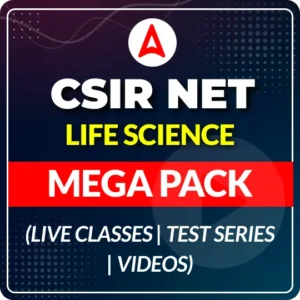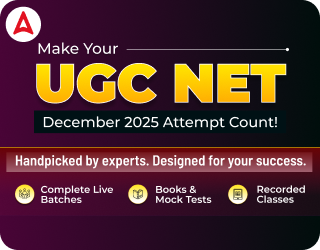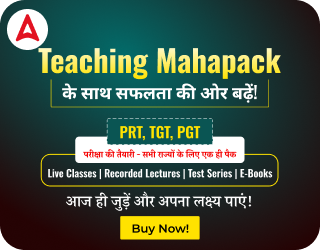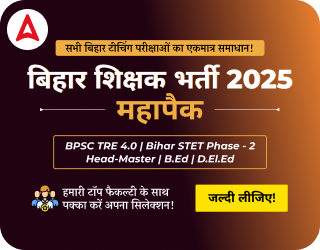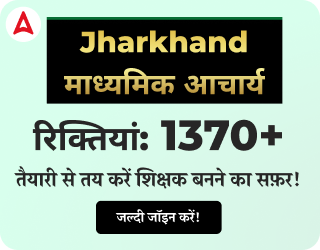Adda247 is India’s best Teaching Jobs Exam Preparation website. We offer high-quality study material and state-of-the-art online assistance and guidance to all teaching job aspirants across the country. Since our inception, we have been offering to teach aspirants comprehensive and up-to-date study materials on all teaching-related exams such as CTET, UPTET, KVS Recruitment, DSSSB, NVS, UGC NET, TNTET, and so on. Adda247 has been playing a crucial role in lakhs of teaching aspirants through the years.
From the latest Teaching Jobs Exam Notification to helping them prepare for these Teaching Job Exams, Adda247 has provided all the relevant and essential information to the teaching aspirants. As we cover all the national and state-level Teaching Jobs Exams, candidates aspiring to become teachers will always find the best mentoring and guidance through us.
Trending
- MP TET Varg 3 Notification 2025 Out, Check Vacancies, Eligibility, Syllabus and Exam Pattern
- CG Vyapam Pre Deled Final Answer Key 2025 Out, Download Response Sheet PDF Here
- CG Vyapam Pre DElEd Result 2025 Out, Direct Download Link Here
- JKSET Previous Year Question Paper, Download PDF
- UGC NET Assistant Professor Salary, Check Benefits, Allowances
- UP ECCE Educator Vacancy in UP 2025 Out, 8800 पदों पर सीधी भर्ती, जल्द यहाँ से करे आवेदन।
- JMI Faculty Recruitment 2025 Out for 357 Posts, Eligibility, Salary, Schedule
- DSSSB PGT Exam Analysis 2025, Difficulty Level and Good Attempts
- AP DSC Response Sheet 2025 Out @apdsc.apcfss.in, Download Subject Wise PDF Here
- MAHA TAIT Result 2025 Out Soon @mscepune.in, Check Merit List, Scorecard
- RRB Teacher Exam Date 2025, Exam Shift and Schedule
- DSSSB PGT Question Paper 2025, Direct Download PDF Here
- REET Certificate 2025 Download link Out @rajeduboard.rajasthan.gov.in
- RRB Teacher Application Status 2025, Check Accepted & Rejected Status Now
Teaching Jobs Exam
The Teaching Jobs Exam is conducted by various government bodies and authorities at the national and state levels. Lakhs of candidates apply for these Teaching Jobs Exam every year. As this Teaching Jobs Exam is tough to crack due to the difficulty level, high competition and limited availability of seats. In keeping all these factors in mind, aspirants often look for assistance in preparation. Adda247 has come up with comprehensive and compact solutions for candidates to be able to ace their Teaching Jobs Exam.
Why Choose Teaching Jobs Exam?
Teaching Jobs Exam is developed with the passion to help, guide, and assist passionate teaching aspirants in the country to fulfill their dreams of becoming Government Teachers. We are equipped with outstanding subject matter experts to help you prepare effectively and efficiently with affordability.
You don’t have to spend your fortunes on high-quality and authentic study materials for preparation for your upcoming Teaching Jobs Exam. As we offer you all the study materials such as e-books, mock tests, test series, video assistance, online classes, and so much more at affordable prices.
Some Important Teaching Jobs Exam
To become a qualified teacher, the candidates must acquire the required educational qualifications as well as clear a Teacher’s Eligibility Test (TET). On top of that, they need to appear in the various Teaching Jobs Exams. for every aspiring teaching candidate, there are some Teaching Jobs Exams and TET Exams that are very important. Here are some of these important Teaching Jobs Exams and TET Exams that are extensively covered by Adda247 along with other Teaching Jobs Exam.
CTET Exam
Central Teacher Eligibility Test or CTET is a national-level eligibility test conducted Central Board of Secondary Education. CTET Certification is a mandatory eligibility criterion for national and state-level Teaching Jobs Exam. Thus, candidates must be CTET Qualified if they wish to become eligible to apply for the various national and state-level Teaching Exams.
UPTET Exam
Uttar Pradesh Teacher Eligibility Test or UPTET is a state-level exam conducted by the Uttar Pradesh Basic Education Board (UPBEB) to test the eligibility of candidates aspiring to become teachers. The UPTET Qualified candidates will become eligible to apply for the various Teaching Jobs Exam in Uttar Pradesh such as Super TET, UP LT Grade Teacher and so on.
KVS Exam
Kendriya Vidyalaya Sangathan conducted the KVS Exams to recruit eligible candidates in Kendriya Vidyalayas across the country. KVS Teacher Notification is one of the most aspired recruitment exams for Teaching Aspirants. The KVS releases vacancies in the post of PRT, TGT, PGT, Principal, and other non-teaching posts as well. KVS Admit card 2025 has been live for all posts on its official website.
DSSSB Exam
Delhi Subordinate Services Selection Board (DSSSB) comes under the Government of NCT of Delhi. DSSSB conducts exams for the recruitment of eligible candidates in various posts like PRT, TGT and PGT. The candidates recruited under DSSSB are posted within the jurisdiction of Delhi in various schools run by the Government of Delhi.
NVS Exam
Navodaya Vidyalaya Samiti is an autonomous body under the Ministry of Education, Government of India. NVS runs a school chain across the country with approximately 650+ schools. Thus, NVS Recruitment is a huge opportunity for teaching aspirants to secure a well-paying Government Teaching Job. Teaching aspirants looking for PRT, TGT and PGT jobs must prepare for NVS Exams.
Super TET Exam
Super TET is a secondary-level exam conducted by Uttar Pradesh Basic Education Board (UPBEB). The candidates interested in applying for the Super TET Recruitment Exam must have either CTET or UPTET Certificate as basic eligibility criteria. The Super TET Exam is conducted every year to fill in vacancies in the Government Schools of Uttar Pradesh for the post of Assistant Teacher.
RPSC Exam
Rajasthan Public Service Commission (RPSC) conducts recruitment exams every year for various Teaching Jobs Exam in Rajasthan. Candidates interested to work in Rajasthan can apply for the RPSC Exams. They must have REET Certificate as a mandatory eligibility criterion along with the required educational qualification.
REET Exam
The Rajasthan Eligibility Examination for Teachers is conducted by the Board of Secondary Education, Rajasthan every year. The REET 2025 Notification is an eligibility test for teaching aspirants conducted at a state level. After securing a REET certificate, candidates become eligible to apply for various PRT and TGT posts within Rajasthan.
Army Public School
Army Public School recruitment exams are conducted by the Army Welfare Education Society every year. Army Public Schools are located across the country. Candidates interested to apply for PRT, TGT, and PGT Posts can apply online to appear for the Entrance Test, however, the final recruitment decision lied on the individual Army Public Schools as per their vacancies available and some other similar factors.

